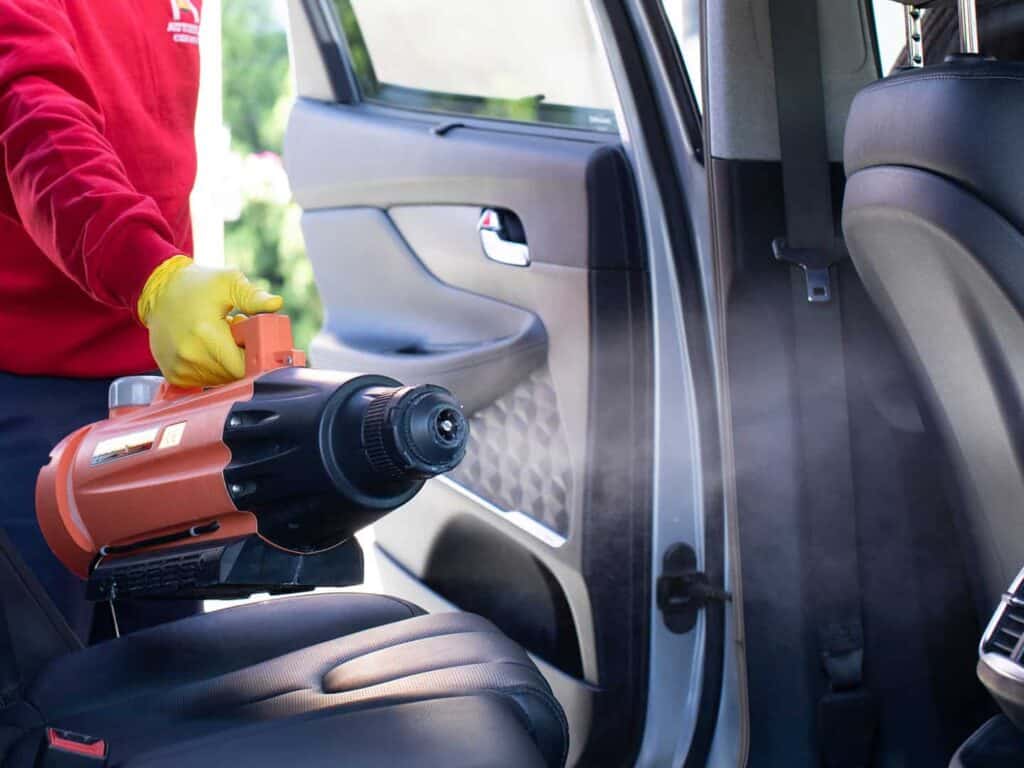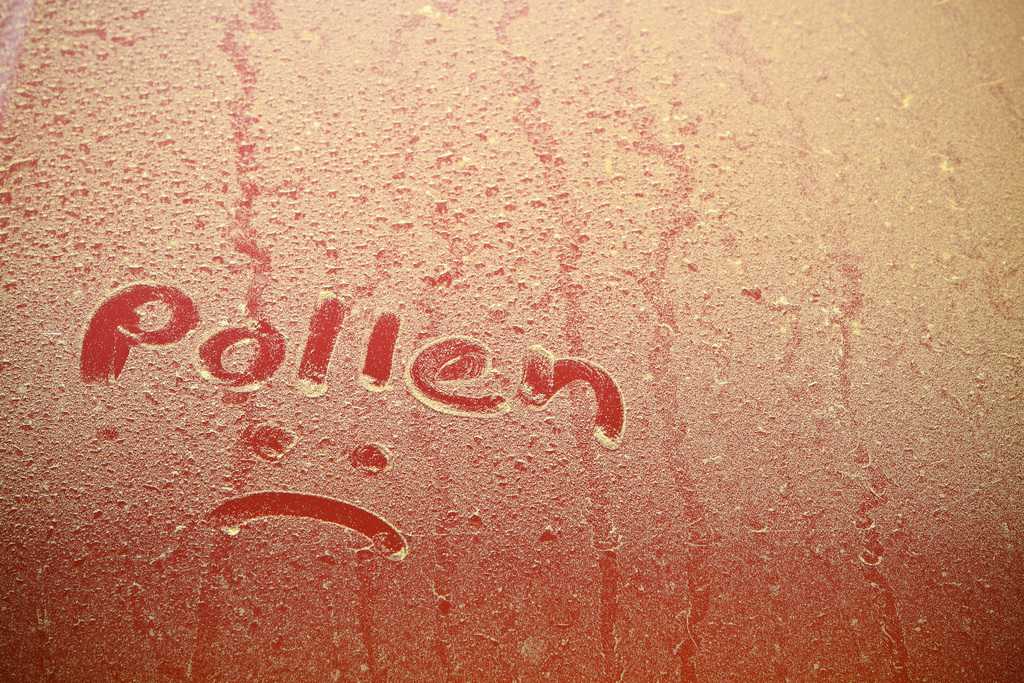Do you smell that? Don’t breath too deeply, but that might be the rank aroma of an allergic reaction doing a sweaty warm-up lap inside your sinuses. Oh but wait… Don’t allergies go well beyond nasal cavities and nostrils? Eyes, olfactory glands, and skin all get the shaft during an allergic reaction, and the amount of offending allergens are pretty damn diverse.
When it comes to allergens and automobiles, pollen isn’t the only thing you have to worry about, even though “tree spunk” is the most prone to making your paintwork look like complete crap. As we discussed a while back in a blog post focusing on awful automotive aromas, everything from animal dandruff and mold, to compromised cabin air filters and fucked-up floor mats have the ability to turn a pleasant car ride into an agonizing experience.
But dive beneath all of the putrid surface particles and gag-inducing aromas, and you’ll unearth an ungodly amount of allergen-laden crud. So while it may be easy to identify a discarded banana peel beneath the rear bench, or a spot of mildew forming on a front seat, the hidden risks of allergens is an issue that deserves a thorough inspection and removal, and here’s why…
Dust Mites and Your Automobile

Allergens can collect pretty much anywhere on this planet, and that includes the varying surfaces that make-up our automobiles. From the dashboard and floorboard, to the trunk and tailgate lever, failure to regularly disinfect your car is all that is needed in order for allergens to make a home in your preferred mode of transportation.
“Keeping your car clean prevents the spread of mites, pollen, dust, bacteria and other substances that damage vehicles. Allergy symptoms such as sneezing or itchy eyes can negatively affect the driver’s ability to react on the road.”
–Istobal
Take dust mites for instance. These eight-legged arthropods feed almost exclusively on the skin we shed every day, and they adore the plush environment provided by man-made materials like carpet, upholstery, and cloth fabrics. This makes automobiles, and the items contained therein, a prime breeding ground for these little shits. Being that these dander-gobbling critters are on every continent save for Antarctica, they have been labeled as the most common trigger of year-round allergies and asthma by the Asthma and Allergy Foundation of America.
Quick Nerd Note: A dust mite measures around one-quarter, to one-third of a millimeter in size, making them impossible to detect with the naked eye. In order for these miniature, crab-like critters to survive almost exclusively on discarded flakes of human skin, they must reside in areas where homo sapiens abide. Since the average adult unknowingly sheds around 1.5 grams of skin every day, up to one million dust mites can thrive in a single enclosed environment as long as it is frequented by their oblivious host. This makes automobiles a prime breeding ground for dust mites, and the allergy symptoms they create.
Allergy Medications and the Dangers of Impaired Driving

The United States of America’s Food and Drug Administration (FDA) has quite a bit to say about driving while under the influence of allergy medications, or antihistamines. These drugs have the ability to counteract allergy-induced histamines and bring relief from these negative reactions.
But many of these antihistamines have the ability to make people feel drowsy, unfocused, and slow to react, all of which can easily affect your driving etiquette. The FDA warns that, “If not taken responsibly and according to directions, they
Another risk is that various antihistamines may be designed to be dosed in different increments. All too often, full-grown adults run out of a particular antihistamine, and make the brilliant decision to “knock-back a few pills” from a different manufacturer. They assume that the results will be the same, but due to the new meds being of a heavier dosage. Throw in a few ill-timed Manhattans, and their entire evening suddenly becomes a blurred mess, as the medications that were supposed to assist quickly turn into a major hindrance.
Quick Nerd Note: When humans (and certain animals) encounter something that triggers their allergies, may it be pollen, ragweed, pet dander, dust mites, bad infomercials, or any number of other offender, it produces chemicals within the body called “histamines.” These histamines are what cause nasal tissue to swell, thus creating that “stuffy nose” everyone dreads. Mucus may begin to discharge from the nose and eyes as well, with itching, and skin rashes following thereafter.
Oh, and let’s not overlook the fact that some antihistamines take far longer to work than others, and take even longer to dissipate. This means that the sedating effects of these medications can linger for a long-ass time after the medication has been administered, with extreme cases lasting well into the next day. It’s like that magical brownie you ate that didn’t seem so strong at first, and now, 12-hours later, you’re attempting nude yoga on your rooftop.
“You may experience slower reaction time, haziness, or mild confusion even if you don’t feel drowsy after taking a medication containing antihistamines.”
-Jane Filie, M.D., Food and Drug Administration’s (FDA) Division of Nonprescription Regulation Development medical officer
It’s also important to avoid consuming alcohol, sedatives (sleeping pills), or tranquilizers while giving allergies an ass-kicking via the use of antihistamines. Alcohol and sedatives are notorious for their ability to amplify an antihistamine’s drowsy side-effects. Throw in the fact that entirely too many people feel “responsible enough” to self-medicate, and opt to not contact their healthcare provider, and the risk of dopey drivers becomes all the more substantial.
How to Clean Your Car to Prevent Allergic Reactions

So if you wish to avoid allergic reactions, or allergens seem to be emanating from your automobile, a thorough interior cleaning should be in order. Forget the quick wipe-down and dry vacuum approach, because you are going to want to go deep on that cabin interior. This means either coughing-up the cash and taking the vehicle to a professional detailer, or renting a steam cleaner, and hitting every centimeter of the vehicle.
Istobal stresses that a properly detailed car should always have its interior cleaned first. For those who are fortunate enough to live near an Istobal cleaning station, it is important to note that in order to prevent a build-up of bacteria, one should always shake and vacuum their car’s floor mats prior to using the company’s mat cleaners. With larger debris and potential allergens safely removed, Istobal’s equipment then applies an antibacterial chemical sanitizer to the mats for additional peace of mind.
For those of you who do not have access to a cutting edge car cleaning station, like Istobal, an old-fashioned interior gutting and disinfecting venture can be put into play. This begins with removal of any personal belongings, all of which should be cleaned separately. Then, with the doors and windows open, use air blowers to remove any dirt or debris that may be trapped within the tight corners and creases of the car. Debris dislodged, it’s now time to go over all of the vehicle’s hard surfaces with an interior detailing spray and a clean microfiber cloth to remove any dust or mildew build-up.
To begin the deep car cleaning process on carpets and upholstery, one must first select a good interior upholstery cleaner and pair it with a high quality interior fabric brush. While the brush will help agitate fibrous surfaces and expose hidden filth, the cleaner will penetrate and lift any allergy-inducing substances to the surface.
As you scrub and spray, be sure to slide the seats around, flip-up or remove the rear bench, and hit the trunk, door pockets, glovebox, and any other ensconced area. After that, feel free to break-out the steam cleaning vacuum or shop vac, to suck-up any gunk the upholstery/carpet cleaner may have brought to the surface. We suggest that before moving on to the more easily reachable areas of the interior, to recline each seat so that you can vacuum the often missed area between the seat and the backrest. The same goes for the “dead space” between the seats and center console, as well as beneath the steering column and underneath the passenger foot well.
Once complete, feel free to polish all interior glass with an ammonia-free automotive glass cleaner and a fresh microfiber towel. After which, you can begin applying things like leather balms and other detailing products to surfaces to add both shine and protection.
Mercedes-Benz: Fighting Allergies One Vehicle at a Time

Of all the automotive manufacturers in the world, Mercedes-Benz seems to be the most adamant about preventing allergens from infiltrating the cabins of automobiles.
According to a report from the German automaker, it’s decision to go on the defensive, and implement an allergen protection program for every one of its vehicles has made a massive difference in cabin air quality. So how does an automaker go about tackling such a task you might ask? By joining forces with the Berlin-based European Centre for Allergy Research Foundation (ECARF). Duh.
“All the new passenger car models from Mercedes-Benz bear the Seal of Quality of the European Centre for Allergy Research Foundation (ECARF). This makes Mercedes-Benz the only vehicle manufacturer to bear this seal. The ECARF Seal of Quality is used by ECARF to designate products that have been scientifically tested and proven to be suitable for allergy sufferers.”
-Mercede-Benz
In true German fashion, ECARF is extremely detail focused, and it’s findings are no different, showing that in today’s industrialized countries, allergic conditions have become: “The most common form of chronic illness.” Take Mercedes-Benz and ECARF’s homeland for example. In Germany, over 30% of the population is affected by allergies every year. This translates to 10% of all work absences being traced to an allergy-related sickness of some sort.
Further research has found that motorists are particularly prone to allergies, as off-gassing emissions emanating from cabin interior materials continues to be linked to illnesses. All it takes is the right amount of sunshine, contact with the surface itself, or the introduction of an unvetted cabin material, for a unpleasant allergic reaction to take hold. ECARF reports that some of the more common, automotive material related symptoms tend to involve the swelling and inflammation of the nasal passage, as well as hay fever and asthma.
In order to offset, or negate these shitty situations all together, Mercedes-Benz has modified every model in its lineup, from the tiny A-Class, to the opulent S-Class, so that they can meet ECARF’s strict allergy criteria. Some of these processes include the conversion of numerous components so that they can pass inhaled allergen tests, with Mercedes-Benz going as far as testing the functions of its signature pollen filters in both new and used condition.
These tests are all done with the help of what the automaker refers to as “human guinea pigs.” Driving tests, for example, are not only completed by individuals with zero history of allergic reaction, but also by those suffering from severe asthma. This not only helps Mercedes-Benz’s engineers and ECARF glean lung function feedback from healthy individuals, but from those with compromised bronchial systems, for those with preexisting conditions buy automobiles as well.
Further steps were made by the luxury brand, when it decided to mandate the dermatological testing of all materials that might come into contact with human skin. The same approach that was taken with individuals suffering from airborne allergies, was implemented once again, but in a slightly different way. These “epicutaneous skin tests” involved exposing test subjects suffering from skin allergies to known contact allergens such as chrome-nickel and various pigmented surface areas. Naturally, one can only assume that these “human guinea pigs” were rewarded handsomely for their voluntary suffering.
And while some people may consider these precautions to be completely overkill, those who suffer from allergies will more than likely call Mercedes-Benz’s decision downright considerate. Just one more example of how automakers are changing the way we drive and thrive a s a race.
Fighting Allergens: More Than Just a Dash of Deep-Cleaning

But not everyone has the financial means to procure an allergy-free Mercedes-Benz automobile. For us peasants, the war on allergens puts us directly on the frontline, and we’re not exaggerating when we say this is an all-out war. In order to arm drivers with practical and effective practices, NAPA Auto has proffered up some sensible strategical advice.
The first thing the automotive parts specialist suggests doing is tossing any furry fabrics that are not permanently affixed to the vehicle. If you need to buy something like seat covers, opt for something with a smooth finish, as they are less likely to collect dust, dandruff, and other unpleasant allergens. While you’re at it, you might as well maintain your car’s integrity, and wash all of that clothing that’s been accumulating in the backseat, because you can bet your ass that it’s crawling with dust mites.
Allergy medicine maker, Claritin, also has its own advice for drivers. It points out that keeping the windows rolled up and using the vehicle’s climate control system on the recirculating cycle will do wonders for preventing pollen and other allergens from infiltrating the cabin.
Another thing to be wary of are cloth car seats, which are prime real estate for allergens like dust mites, and are prone to promoting mold if not cleaned regularly. Instead, opt for leather, or faux leather seats when buying a vehicle, as smooth surfaces offer far less room for allergens and odors to take hold.
Finally, Claritin stresses that the timely removal of damp fabrics will help keep mold spores from colonizing and spreading. And while keeping an allergy medicine in the vehicle at all times is not a bad idea, our previous chat about the dangers of mixing antihistamines with driving warrants careful consideration.
Quick Final Tip: Replacing your car’s cabin air filter will do wonders for reducing airborne allergens. Although a scheduled replacement should take place every 12,000 to 15,000 miles, a lot of people forget to do so, especially when the vehicle is out of warranty or is not serviced regularly by a dealership. Want to skip the worry and remove even more allergens from your car’s interior? Companies like K&N make reusable cabin air filters to capture allergy-inducing gunk, and typically come backed by money-back guarantees and impressive warranties.













1 comment
Exotica leathers
“Discover the hidden dangers of driving with allergens and how to protect yourself. Your health and car deserve the best care
“Discover the hidden dangers of driving with allergens and how to protect yourself. Your health and car deserve the best care